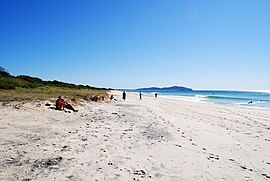Booti Booti National Park
|
Booti Booti National Park New South Wales |
|
|---|---|
|
IUCN category II (national park)
|
|

A view of Seven Mile Beach, some of which is contained within Booti Booti National Park
|
|
| Nearest town or city | Forster-Tuncurry |
| Coordinates | 32°14′40″S 152°32′36″E / 32.24444°S 152.54333°ECoordinates: 32°14′40″S 152°32′36″E / 32.24444°S 152.54333°E |
| Established | 1992 |
| Area | 15.67 km2 (6.1 sq mi) |
| Managing authorities | National Parks and Wildlife Service (New South Wales) |
| See also | Protected areas of New South Wales |
Booti Booti National Park is a national park in New South Wales, Australia, 282 kilometres (175 mi), by road, north-north-east of Sydney. The holiday town of Forster-Tuncurry lies immediately to the north.
The first European to inhabit the area was a Captain J. Gogerly who sailed from Forster to Sydney with loads of timber. He and some of his family are buried in the park. Mining for mineral sands took place at Seven Mile Beach from 1969 to 1975, and at Elizabeth Beach from 1969 to 1970. The park was declared a state recreation area from 30 September 1977, then a national park in 1992.
Geographically, the National Park is made up of three hill complexes – the 224 m high Cape Hawke to the north, and 169 m high Booti Hill and 96 m high Charlotte Head in the southern end. The three areas are connected by low–lying estuarine and aeolian sands. The stretch of land between Cape Hawke and Booti Hill is around 10 km long and ranges between 400 m and 3.25 km wide. It separates Wallis Lake from the ocean. Cape Hawke and Charlotte Head were once islands, which became joined to the mainland by built-up sand deposits.
654 species of native plants have been recorded from Booti Booti National Park. This formed 46 distinct plant communities within the park boundaries. 17% of the park is classified as rainforest. Seven distinct wet sclerophyll forest and ten dry sclerophyll forest communities have been recorded.
Five species recognised as threatened by the New South Wales Government occur within the park – these are Allocasuarina defungens, A. simulans, Chamaesyce psammogeton, Cynanchum elegans and Senna acclinis.
...
Wikipedia

